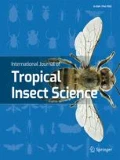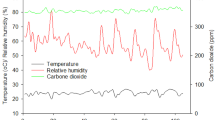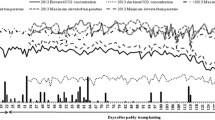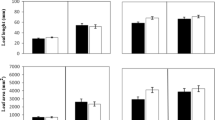Abstract
Pink Stem Borer, Sesamia inferens Walker (Lepidoptera: Noctuidae) incidence has increased on graminaceous crops in the north-western plains of India during recent years. To understand the effect of climate change on the northward spread of the pest, studies on the growth and development of S. inferens on maize (Zea mays L.) were planned with combinations of temperature and CO2. The combinations were 27: 22 °C and 375 ppm of CO2, 32: 26 °C and 375 ppm of CO2, 27: 22 °C and 450 ppm of CO2 and 32: 26 °C and 450 ppm of CO2. Various developmental parameters of S. inferens were analyzed using analysis of variance for the main effects of temperature and CO2 and their interactions. At elevated temperature, the growth of egg, larval and pupal stages were faster and the developmental period decreased by 30.9%. At elevated CO2, the larval and pupal development delayed and there was 5.7% increase in developmental period. Both temperature and CO2 individually and in combination significantly influenced adult longevity. Adult longevity reduced 24.9% and 21.7% in male and female, respectively at elevated temperature. Whereas, at elevated CO2, adult longevity increased 7.6% in male and 6.8% in female, respectively. The fecundity was positively influenced (+10.8%) by elevated temperature and negatively (−14.4%) by elevated CO2. The effects of temperature and CO2 on the development of pink stem borer were opposite, with temperature being positive and predominant in influencing the biology of S. inferens. So, it is probable that the faster development of S. inferens on maize in the warm climate might slightly get mitigated by the adverse effect of elevated CO2. The overall effect of rapid development of pest population and damage on maize on large area basis needs to be further investigated.


Similar content being viewed by others
References
Aasman K (2001) Effect of temperature on development and activity of maize stem borer Chilo partellus. Bull Envir Ent 22:125–127
Abrell L, Guerenstein PG, Mechaber WL, Stange G, Christensen TA, Nakanishi K, Hildebrand JG (2005) Effect of elevated atmospheric CO2 on oviposition behavior in Manduca sexta moths. Glob Chang Biol 11:1272–1282. https://doi.org/10.1111/j.1365-2486.2005.00989.x
Aggarwal R, Singh J, Shukla KK (2004) Biology of pink stem borer, Sesamia inferens Walker on rice crop. Indian J Ecol 31:66–67
Akbar SMD, Pavani T, Nagaraja T, Sharma HC (2015) Influence of CO2 and temperature on metabolism and development of Helicoverpa armigera (Noctuidae: Lepidoptera). Environ Entomol 45:229–236
Anonymous (2014) Integrated Pest management package for maize. National Centre for Integrated Pest Management, New Delhi, p 44
Areekul S, Chamchanya T (1973) Effect of humidity, temperature and light on the growth and development of Sesamia inferens (Walker). Kasetsart J 7:65–75
Asshoff R, Hättenschwiler S (2005) Growth and reproduction of the alpine grasshopper Miramella alpine feeding on CO2-enriched dwarf shrubs at treeline. Oecologia 142:191–201
Atwal AS, Dhaliwal GS (1997) Agricultural pests of South Asia and their management. Kalyani Publishers, New Delhi, pp 179–200
Damos P, Savopoulu-Soultani M (2012) Temperature driven models for insect development and vital thermal requirements. Psyche 2012:1–13
De Lucia EH, Nabity PD, Zavala JA, Berenbaum MR (2013) Climate change: resetting plant-insect interactions. Pl Physiol 160:1677–1685
Deole S, Dubey VK, Mehta N (2013) First record of the pink stem borer Sesamia inferens Walker in maize crop at Raipur (Chhattisgarh) region. Insect Envir 19:164–165
Enete AA, Amusa AT (2010) Challenges of agricultural adaptation to climate change in Nigeria: a synthesis from the literature. Field Actions Science Reports. https://factsreports.revues.org/678
Goverde M, Erhardt A (2003) Effects of elevated CO2 on development and larval food-plant preference in the butterfly Coenonympha pamphilus (Lepidoptera: Satyridae). Glob Chang Biol 9:74–83
Hunter MD (2001) Effects of elevated atmospheric carbon dioxide on insect-plant interactions. Agric For Ent 3:153–159
IPCC (2001) Climate change 2001: the scientific basis. Contribution of working group I to the third assessment report of the intergovernmental panel on climate change. Cambridge University Press, Cambridge
IPPC (2018) Report on fall armyworm (Spodoptera frugiperda) IPPC official Pest report, no. GHA-01/4. FAO, Rome https://www.ippc.int/
Kaur J, Kumar P, Singh J, Suby SB, Bajya DR (2015) Egg laying pattern of Sesamia inferens on maize (Zea mays). Indian J Agric Sci 85:109–113
Khadar BA, Prabhuraj A, Rao MS (2014) Influence of elevated CO2 associated with chickpea on growth performance of gram caterpillar, Helicoverpa armigera (Hübner). Appl Ecol Environ Res 12:345–353
Khan ZR, Litsinger JA, Barrion AT, Villanueva FFD, Fernandez NJ, Taylor LD (1991) World bibliography of rice stem borers. International Rice Research Institute, Los Banos, pp 1–426
Kumar SP, Siddiqui KH (1993) Compounding artificial diets for rearing the pink stem borer, Sesame inferens Walker. J Ent Res 17:81–90
Mironidis GK, Savopoulou-Soultani M (2008) Development, survivorship and reproduction of Helicoverpa armigera (Lepidoptera: Noctuidae) under constant and alternating temperatures. Environ Entomol 37:16–28
Muthusamy S, Shanker C, Mohan M, Padmavathi SK, Katti G (2014) Emergence pattern, reproductive biology and courtship behaviour of rice pink stem borer, Sesamia inferens (Walker) (Noctuidae: Lepidoptera). Agrotechnology 2:60
Norby RJ, Willschleger SD, Gunderson CA, Johnson DW, Ceulemans R (1999) Tree responses to rising CO2 in field experiments: implications for the future forest. Plant Cell Environ 22:683–714
Owensby CE, Ham JM, Knapp AK, Auen LM (1999) Biomass production and species composition change in a tallgrass prairie ecosystem after long-term exposure to elevated atmospheric CO2. Glob Chang Biol 5:497–506
Parmesan C (2006) Ecological and evolutionary responses to recent climate change. Annu Rev Ecol Evol Syst 37:637–669
Rajendra A (1976) Studies on Sesamia Inferens Wlk. The shoot-borer pest of sugarcane in Sri Lanka. J Nat Sci Coun Sri Lanka 4:99–108
Rao MS, Manimanjari D, Vanaja M, Rao RCA, Srinivas K, Rao VUM, Venkateswarlu B (2012) Impact of elevated CO2 on tobacco caterpillar, Spodoptera litura on peanut, Arachis hypogea. J Insect Sci 12:103. https://doi.org/10.1673/031.012.10301
Rao MS, Srinivas K, Vanaja M, Manimanjari D, Rao CAR, Venkateswarlu B (2013) Response of multiple generations of semilooper, Achaea janata feeding on castor to elevated CO2. J Environ Biol 34:877–883
Sekhar JC, Rakshit S, Kumar P, Mehrajuddin AM, Dass S (2008) Differential reaction of CIMMYT maize lines and their hybrid combinations to pink borer, Sesamia inferens Walker. Ann Pl Prot Sci 16:404–406
Selvaraj K, Chander S, Prasannakumar NR (2014) Determination of thermal constant and development threshold of pink borer, Sesamia inferens Walker. Proc Natl Acad Sci India Sect B Biol Sci 85:659–662
Shorey HH (1963) The biology of Trichoplusia ni (Lepidoptera: Noctuidae). II. Factors affecting adult fecundity and longevity. Ann Entomol Soc Am 56:476–480
Singh B (2012) Incidence of the pink noctuid stem borer, Sesamia inferens (Walker), on wheat under two tillage conditions and three sowing dates in North-Western plains of India. J Entrep 9:368–374
Singh G, Jindal J, Kumar M (2014) Incidence and extent of losses by cob borer complex on Kharif maize in Punjab. Proceedings of international conference: changing scenario of Pest problems in Agri-horti ecosystem and their management. Entomological Research Association, Maharana Pratap University of Agriculture and Technology, Udaipur, p 171
Tejusing, Shrikant, Bandeppa (2014) Influence of elevated CO2 on biology of Bihar hairy caterpillar, Spilosoma obliqua (Wlk.) on castor. J Ent Res 38:169–172
Viswajyothi K, Aggarwal N, Jindal J (2017) Thermal indices of pink stem borer, Sesamia inferens Walker on maize in North-Western Plains of India. Indian J Ecol 44:893–897
Viswajyothi K, Aggarwal N, Jindal J (2019) The biology of Sesamia inferens (Walker) (Lepidoptera: Noctuidae) on maize in the North Western Plains of India. Acta Phytopathol Entomol Hung 54:87–102. https://doi.org/10.1556/038.54.2019.008
Wu G, Chen FJ, Ge F (2006) Response of multiple generations of cotton bollworm Helicoverpa armigera (Hübner), feeding on spring wheat, to elevated CO2. J Appl Entomol 130:2–9
Xie H, Liu K, Sun D, Wang Z, Lu X, He K (2015) A field experiment with elevated atmospheric CO2-mediated changes to C4 crop-herbivore interactions. Sci Rep 18:1–9
Yin J, Sun Y, Wu G, Ge F (2010) Effects of elevated CO2 associated with maize on multiple generations of the cotton bollworm, Helicoverpa armigera. Ent Exp Appl 136:12–20
Acknowledgments
We thank the Department of Entomology, Punjab Agricultural University, Ludhiana for providing the facilities and funding for conducting the research successfully.
Author information
Authors and Affiliations
Contributions
NA and JJ conceived and designed research. VK conducted the experiments and analyzed the data. All authors contributed to writing the paper. All authors approved the manuscript.
Corresponding author
Ethics declarations
Competing interests
The authors declare that they have no competing interests.
Additional information
Publisher’s note
Springer Nature remains neutral with regard to jurisdictional claims in published maps and institutional affiliations.
Rights and permissions
About this article
Cite this article
Viswajyothi, K., Jindal, J. & Aggarwal, N. The effect of temperature and CO2 on the development of pink stem borer on maize. Int J Trop Insect Sci 40, 63–69 (2020). https://doi.org/10.1007/s42690-019-00052-3
Received:
Accepted:
Published:
Issue Date:
DOI: https://doi.org/10.1007/s42690-019-00052-3




